While it may be summer right now, it’s no excuse to skimp on preparations for ski season.
Skiing is only for a few months at any given year, and it can shock your body if you hit the slopes without going through necessary conditioning.
So before you start getting good ‘ol powder in your face or going through men’s ski helmets from Giro, get these exercises in to avoid injuries.
Cardio work
Putting in cardio work is essential before the ski season. Running is a reasonably straightforward workout that you can do. Just grab a pair of decent running shoes, and you’re good to go. Plus, it’s a good cross-training option during the warmer months of the off-season.
If you’re a typical weekend warrior and you’re at least a month away, it’s good to log in anywhere 12 to 20 of running miles a week. But if you’re a more serious skier, put in at least two months of cardio preparation, with a minimum of 30 running miles per week.
For low-impact, you can hop on an elliptical trainer or bike — stationary or otherwise — and get at least a good 45 minutes to get your lungs and legs in shape.
Build leg strength
 While skiing hits several muscle groups across the body, your legs will need special attention — or punishment, depending on how you look at it. You’re going to be relying a lot on your quadriceps, hamstrings, and glutes to hold up under pressure.
While skiing hits several muscle groups across the body, your legs will need special attention — or punishment, depending on how you look at it. You’re going to be relying a lot on your quadriceps, hamstrings, and glutes to hold up under pressure.
- Try mixing in alternating lunges into your routine, with a goal of ten to 15 repetitions and three to four sets. If you’re feeling motivated, do 20 reps or more. Keep your feet apart and lunge forward with either your right or left foot. Maintain a 90-degree angle with that leg. Keep your other extended leg from touching the floor — just ever so slightly hovering above it. Then push off your bent leg using your heel to return to your original stance. Then repeat with the other leg. ;
- Squat workouts are another excellent way to condition your legs. To make things challenging, try jump squats — eight to 12 reps of four sets. The only difference is that before rising from a semi-seated position, shift your weight to the balls of your feet then jump upward. Make sure your feet make a soft landing.
Work your obliques
When you’re going down a mountain, you’re going to be doing a lot of twisting and turning to navigate appropriately. That’s where your oblique muscles — and other core muscles — come in to help you execute the right movements.
Russian twists are core-specific, and they should be part of your training. Start executing three sets with 12 to 20 reps each.
Have a kettlebell ready on the side as you sit down on the floor. Hips and knees should bend at 90 degrees. Grab the kettlebell and bring it to the other side with control. As you do this, make sure your feet are hovering slightly above the ground, and your core is engaged. Then twist back to the first side where you started and repeat.
If you don’t have a kettlebell, a weight plate or dumbbell will more than suffice. If you can’t lift the weight with your feet off the floor, it’s alright to bring them down while executing the reps. Depending on your strength level, you can start with either a light or heavy set of weights.

